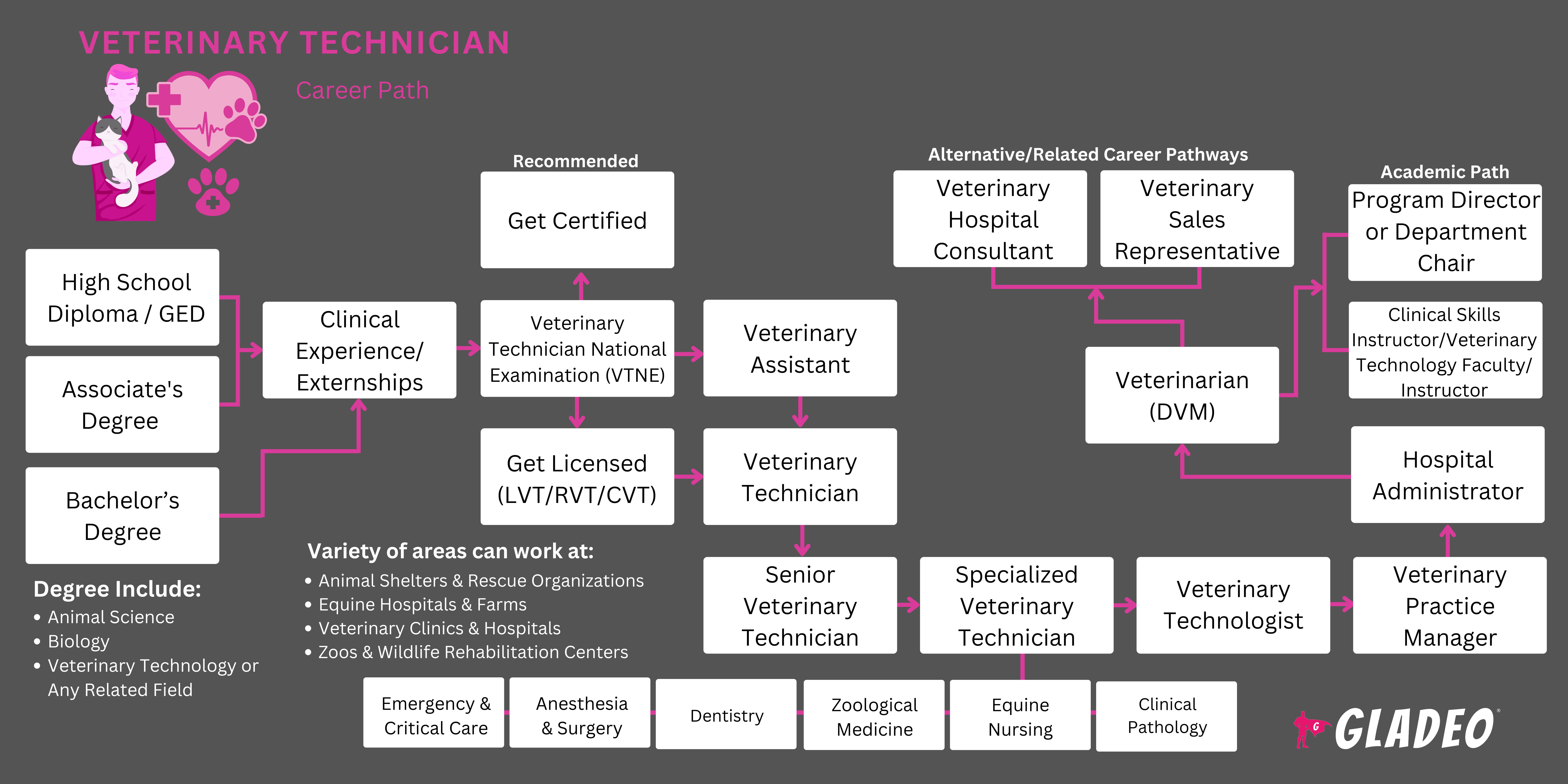스포트라이트
Certified Veterinary Technician (CVT), Emergency Veterinary Technician (Emergency Vet Tech), Internal Medicine Veterinary Technician (Internal Medicine Vet Tech), Licensed Veterinary Technician (LVT), Registered Veterinary Technician (RVT), Veterinarian Technician (Vet Tech), Veterinary Laboratory Technician (Vet Lab Tech), Veterinary Nurse (Vet Nurse), Veterinary Technician (Vet Tech), Veterinary Technologist
Veterinary technologists and technicians do medical tests that help diagnose animals’ injuries and illnesses.
- Caring for animals
- Working with animals
- Every day is different!
- Observe the behavior and condition of animals
- Provide nursing care or emergency first aid to recovering or injured animals
- Bathe animals, clip nails or claws, and brush or cut animals’ hair
- Restrain animals during exams or procedures
- Administer anesthesia to animals and monitor their responses
- Take x rays and collect and perform laboratory tests, such as urinalyses and blood counts
- Prepare animals and instruments for surgery
- Administer medications, vaccines, and treatments prescribed by a veterinarian
- Collect and record animals’ case histories
- 커뮤니케이션 기술
- 동정심
- 세부 사항 중심
- Manual dexterity
- Physical strength
Veterinary technicians generally work in private clinical practices or animal hospitals under the guidance of a licensed veterinarian.
Veterinary technologists typically work in more advanced research-related jobs, usually under the guidance of a scientist or veterinarian. Some technologists work in private clinical practices. Working primarily in a laboratory setting.
- Physically or emotionally demanding
- Risk injury on the job. They may be bitten, scratched, or kicked while working with scared or aggressive animals.
- Might work weekends and evenings.
- Loved animals
- Helped friends or family members when they got injured
- Veterinary Technicians typically need an associate’s degree in veterinary technology
- Note, that technologists and technicians have different educational requirements. A “technologist” needs a bachelor’s
- Vet technology programs usually feature access to areas where students can work directly with animals on campus, as well as at veterinary hospitals and clinics via externships
- Portland Community College’s program lists topics students will learn about, such as:
- how to administer vaccinations and medications
- perform oral care
- collect diagnostic specimens
- educating owners about animal behavior
- maintaining medication and supply inventories
- preparing patients for surgery
- developing radiographs
- Programs must be accredited by the American Veterinary Medical Association, which offers a list of accredited college programs here
- After graduation, Vet Technicians must pass the Veterinary Technician National Examination (managed by the American Association of Veterinary State Boards, or AAVSB) to work in most states
- The exam features 150 questions (plus 20 “pilot” questions that aren’t scored). Test takers have three hours to complete the exam
- Exams are scored from 200 - 800. 425 is the minimum passing score
- Pass rates vary, so it is critical to select a good training program and to study hard. Many students purchase optional study materials
- Students can use ASVSB’s Licensing Boards for Veterinary Medicine tool to find contact info for their state’s board
- Additional certification options include:
▸ Veterinary Internal Medicine Technician - Oncology
▸ Veterinary Internal Medicine Technician - Large Animal Internal Medicine
▸ Veterinary Internal Medicine Technician - Cardiology Academy of Internal Medicine for Veterinary Technicians
▸ Veterinary Internal Medicine Technician - Small Animal Internal Medicine Academy of Internal Medicine for ▸ Veterinary Technicians
▸ Veterinary Internal Medicine Technician - Neurology Academy of Internal Medicine for Veterinary Technicians
- Academy of Veterinary Nutrition Technicians - Veterinary Technician Specialist - Nutrition
- American Association for Laboratory Animal Science -
▸ Laboratory Animal Technologist
▸ Laboratory Animal Technician
▸ Assistant Laboratory Animal Technician
- American Association of Veterinary State Boards - Veterinary Technician National Exam
- American College of Veterinary Pathologists - Veterinary Anatomical Pathology Phase II
- American Farrier's Association -
▸ Certified Farrier
▸ Certified Journeyman Farrier American Farrier's Association
▸ Certified Journeyman Farriers - Therapeutic Endorsement
▸ Certified Journeyman Farrier - Educators Endorsement
▸ Certified Tradesman Farrier
▸ Certified Journeyman Farriers - Forging Endorsement
- International Association of Equine Dentistry - Certified Equine Dental Technician
- Veterinary Hospital Managers Association - Certified Veterinary Practice Manager
- Take college prep classes in high school, including biology, chemistry, and math
- Consider taking physical education or developing an exercise routine so you’ll have the strength to lift some animals, as needed
- Don’t neglect developing your soft skills, such as communication and “bedside manner.” Animal owners get very attached and often think of their animals as family members
- Get as much experience as you can working around animals, either through volunteerism, part-time jobs on farms or animal shelters, or even pet grooming!
- Make connections while doing your externship. They might need you back full-time after you graduate and pass your credentialing exam
- Practice good safety protocols while working with animals to ensure no one is injured — including the animals. Animals can get scared easily, causing them to bite, claw, or kick anyone near them. There’s also a risk that can hurt themselves jumping off a table or running out of an office
- See if you can shadow a working Veterinary Technician for a day or two to learn their work routine
- Review local job ads in advance to learn more about the qualifications employers are seeking
- Read or watch interviews with Veterinary Technicians and learn about the various areas they might specialize in
- Be aware that some technicians may have to perform euthanasia work, depending on the state where the person is employed (and the specific roles an employer assigns)
- 근무하려는 주에 대한 구체적인 라이선스 요건에 대해 알아보세요.

- Build strong connections while studying and doing externships. Don’t be shy asking about job opportunities!
- Treat animals with care and patience and remember their owners, too! Owners can put in a good word for you with veterinarians, but can also complain and hurt your chances of getting hired
- Be proactive! Sign up for alerts on job portals like Indeed, Simply Hired, and Glassdoor. Upload your resume/CV to make it easier for employers to find you. Call local veterinary service providers and colleges to inquire about upcoming opportunities
- Ask your school or program about any job-seeking resources they might offer
- Check out Veterinary Technician resume templates for ideas on formatting and phrasing
- Review sample Veterinary Technician interview questions. Pay attention to what sort of responses employers could be looking for
- Make sure to conduct a few practice mock interviews and remember to dress for interview success!
- Keep your social media professional at all times
웹 사이트
- Academy of Internal Medicine for Veterinary Technicians
- Academy of Veterinary Dental Technicians
- Academy of Veterinary Nutrition Technicians
- American Animal Hospital Association
- American Association for Laboratory Animal Science
- American Association of Veterinary State Boards
- American College of Veterinary Pathologists
- American Farrier's Association
- American Society for Clinical Pathology
- American Veterinary Medical Association
- Association of Zoo Veterinary Technicians
- International Association of Equine Dentistry
- National Association of Veterinary Technicians in America
- Society of Veterinary Behavior Technicians
- Veterinary Hospital Managers Association
도서
- McCurnin's Clinical Textbook for Veterinary Technicians and Nurses, by Joanna M. Bassert VMD
- Medical Mathematics and Dosage Calculations for Veterinary Technicians, by Robert Bill
- Veterinary Technician's Daily Reference Guide: Canine and Feline, by Candyce M. Jack , Patricia M. Watson , et al.
뉴스피드

주요 채용 정보

온라인 강좌 및 도구







